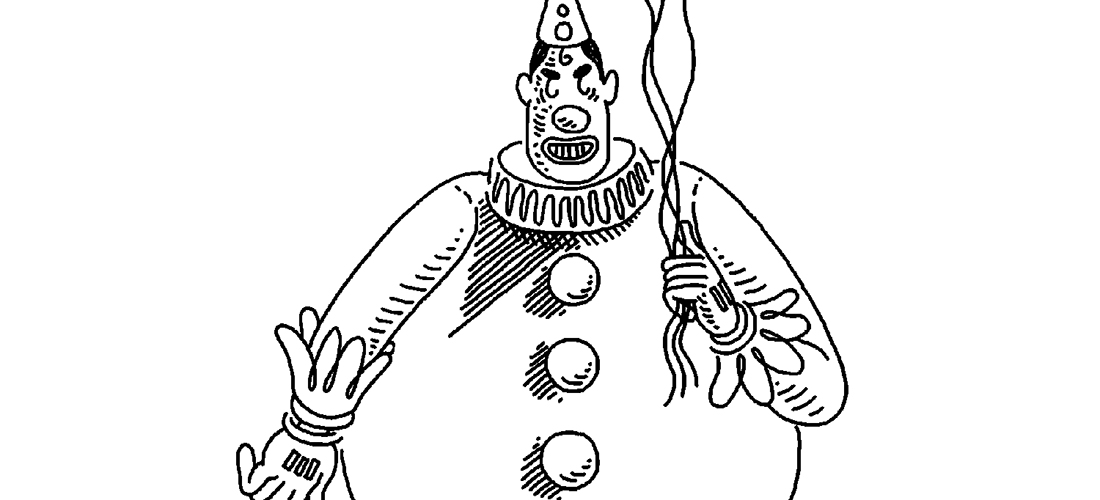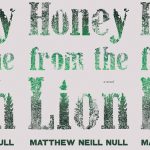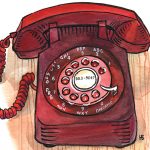
By Jim Dodson
I was deep in the country at twilight, heading home with the radio on when I heard about the dark clowns. The BBC presenter sounded skeptical, even amused by reports out of Greenville, South Carolina, where people dressed as clowns were reportedly trying to lure children into the woods with candy and money.
“So . . . is this just a hoax or something people there are really concerned about?” the host asked a local reporter covering the story, his tongue half in cheek.
“I can’t say it’s a hoax,” she replied, “because the police are taking this very seriously. They have warned parents and doubled patrols. This really has a lot of people freaked out.”
So-called “after-dark clowns” have been spooking America quite a bit lately, it turns out, most recently in Winston-Salem and Green Bay, Wisconsin, where a photograph of a dark clown roaming early morning streets carrying black balloons set the Internet on fire. Two Octobers ago residents of Bakersfield, California, were spooked by photographs of “evil after-dark clowns” roaming their streets after hours, showing up under lampposts and frequenting kiddie rides. Since then, reports of dark clowns have cropped up in a dozen other places around the country.
“The police don’t know whether the stories are coming from the imaginations of children or something sinister is afoot, but panicked residents seem to be taking the law into their own hands,” The New York Times noted about this latest outbreak of clowns in South Carolina, adding that shots had been fired into wooded areas where the sightings occurred.
Whatever else may be true, clowns occupy a peculiar space in American popular culture, somewhere between what’s perfectly innocent and downright terrifying. My September issue of Smithsonian notes that clowns have been with us since man’s earliest days in the guise of everything from mythologized tricksters to painted medicine men. Pygmy clowns entertained bored Egyptian pharaohs, and medieval court jesters were entitled to thumb their oversized noses at the king without fear of losing their heads. Ancient Rome had professional clowns whose job it was to pacify unruly crowds at festivals, peacekeepers who kept an eye out for troublemakers. “Well into the 18th and 19th century,” writes Smithsonian’s Linda Rodriguez McRobbie, “the prevailing clown figure of Western Europe and Britain was the pantomime clown, who was sort of a bumbling buffoon.”
Once, standing in a crowd of camera-wielding tourists next to my young daughter on the main drag in Jackson Hole, Wyoming, awaiting a parade of local rodeo riders, I spotted a mime working the crowd and approaching us. My daughter was delighted. But I wasn’t.
Mimes have always made me uncomfortable, a modest phobia I trace to a powerful moment in my early childhood in Mississippi, where my father briefly owned a small newspaper. One evening in the late fall he took my brother and me to a political rally in a cornfield just outside town where a group of strange people showed up wearing white robes and hoods and stood around a bonfire. We didn’t stay long, just long enough for our father to get a quote or two from the mayor and the hooded figures and to frighten the bug juice out of his sons. We asked our dad why those men wore hoods. “Because people who wear masks are weak people often up to no good,” he replied. Our mother gave him holy hell when she found out where he’d taken us just to harvest a quote.
Forty years later, picking up on my post-Klan jitters, the mime paused right in front of us and attempted to make me smile. He made a huge happy face followed by a tragic sad one, rubbing away imaginary tears when I wouldn’t yield. The crowd ate it up.
“Thanks,” I said through gritted teeth. “Feel free to move along now.”
Clowns were everywhere in the America where I grew up. Most were fun-loving and perfectly innocent in those faraway days — Clarabell the Clown on Howdy Doody and Bozo the Clown with his internationally syndicated show — which according to Smithsonian had a 10-year waiting list for tickets.
There was even a clown I liked on my favorite weeknight TV show, Red Skelton’s alter ego Clem Kadiddlehopper, a bumbling painted-up fool who was tolerable only because he often broke up halfway through his skits. In my bedroom I even had a harlequin desk lamp. I attended Ringling Bros. and Barnum & Bailey Circus about that time, exactly once, on the other hand, feeling bad for the animals and truly bothered by the clowns. Only the acrobats appealed to me.
“So the question is,” Smithsonian’s McRobbie wonders, “when did the clown, supposedly a jolly figure of innocuous, kid-friendly entertainment, become so weighed down by fear and sadness? When did clowns become so dark?”
The truest answer is, long ago and far away.
Classical operas and Shakespearean dramas, after all, have long used clown figures as sinister messengers of mystery and intrigue. But in the modern American context it may well have been an evil clown named Pogo who established the motif of the dark clown around town.
His real name was John Wayne Gacy Jr., a friendly chap who entertained children in the Chicago suburbs for years during the middle 1970s before he was arrested, tried and convicted of killing 33 young men. “You know,” he reportedly told investigators, “a clown can get away with murder.” Before Gacy faced execution in 1994, America’s Crown Prince of Killer Clowns spent his time in his cell painting pictures of clowns and self-portraits of himself as Pogo the clown.
After seven years of writing about dark things for my magazine in Atlanta, I officially swore off watching horror films after writing a piece for Boston magazine about a reclusive teen in western Massachusetts whose mother allowed her son to gorge himself on the Friday the 13th films only to have her troubled son don a hockey mask one Halloween night and slash several kids before hanging himself in the woods. The psychologist who’d been treating him for years told me “his identification with Jason seemed pretty harmless.”
A toxic flood of even more ghastly films continues to flow into your local Cineplex, feeding our insatiable desire to terrify ourselves. Heath Ledger’s brilliant if disquieting Joker in the 2008 Batman remake The Dark Knight seemed almost too real and sadly prefigured the gifted actor’s own demons rising to the surface when he shortly died of an accidental drug and alcohol overdose.
I sometimes wonder if we aren’t simply hardwired to value a good harmless scare in a world that appears damaged beyond repair and full of very real dangers, providing new purpose to whatever bogeyman has always lurked beneath the bed. In another age, after all, fairy tales and fables of trolls loitering beneath bridges and witches in the woods were meant to instruct children on the dangers of straying too far beyond the light or down a road of ruin, real or imagined. “Always keep a-hold of Nurse,” goes a famous ditty by a French writer, Hilaire Belloc, “for fear of finding something worse.”
Once upon a time, Madge the beautician and Speedy Alka-Seltzer were icons of commercial television spots. They’ve given way to pharmaceutical companies peddling expensive drugs for maladies whose side effects may kill you, security firms eager to surveil your home against intruders who are just waiting to pounce, identity theft, and internet investment firms that torched your 401-K plan a few years back while reminding you that you haven’t put aside nearly enough for a “happy” retirement.
Perhaps this explains why Americans can’t seem to get enough of Halloween’s faux gore and fright wigs, projected to shell out a record $7 billion or $75 per ghoul among those celebrating the holiday this year — rivaling Christmas retail.
It’s all part of the funhouse ride that thankfully isn’t real, and every town larger than the hips on a snake seems eager to cash in on the phenomenon with its own haunted corn maze or woods of terror peopled by chain saw–wielding psychos and evil clowns, bless their dark little hearts.
In a broader context, all our lives are challenged by Dark Clowns of one kind or another and things that go bump in the night — a sick child, a worrying diagnosis, a lost job. The worry list is endless.
Maybe the way to fight back is to simply make light of such darkness the way John Candy did in the 1989 John Hughes’ classic Uncle Buck. In one of my favorite scenes in the movie, a drunken clown shows up to entertain at a children’s birthday party where Uncle Buck Russell, good-natured loser — played to perfection by the late great Candy — is babysitting his nephew and two nieces. Upon discovering that the clown is drunk from an all-night bachelorette party, Uncle Buck suggests the clown’s behavior is inappropriate for children. Offended, the clown snarls, “In the field of local live home entertainment, I’m a god.” At which Uncle Buck points to the clown’s rodent-eared VW and firmly says, “Get in your mouse and get out of here,” and proceeds to flattens the clown’s big fat rubber nose to drive home the point.
According to Smithsonian, only 2 percent of grown-ups suffer from excessive fear of clowns, technically a phobia called coulrophobia.
But don’t try telling that to the anxious parents of Green Bay, Bakersfield and Greenville anytime soon.
Truthfully, I’m more worried about some of the dark clowns we’ll have to decide between in the voting booth a few days after Halloween. Bottom line, if a dark clown is foolish enough to show up at my door on Halloween night, don’t be surprised if I give him a shot of John Candy to remember me by. PS
Contact editor Jim Dodson at jim@thepilot.com.





